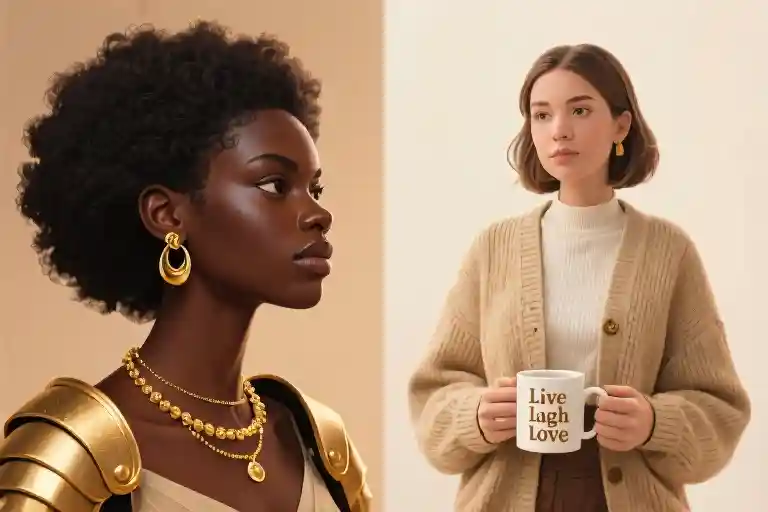The question lingered in my mind for months before I dared to voice it aloud: Is it just me, or are other middle-aged women questioning their gender? What began as a private whisper eventually became an essay—one I wrote with trembling fingers and racing heart, unsure how it would be received. That piece became my quiet rebellion against everything I’d been taught about womanhood, a tentative step toward understanding why femininity always felt like a costume I couldn’tt quite fit into.
Writing about my patriarchal deprogramming—particularly how it shaped my relationship with gender—felt like cracking open a lifelong secret. I described the subtle and not-so-subtle ways both men and women had policed my gender expression since childhood. The backhanded compliments about being ‘too assertive for a girl.’ The bewildered stares when I skipped baby showers for hiking trips. The sinking realization that no matter how hard I tried, I kept failing some invisible test of proper womanhood.
Exploring nonbinary identity didn’t erase my connection to womanhood so much as expand it, creating breathing room between societal expectations and my authentic self. The freedom to say I don’t have to perform became revolutionary. Sharing this journey publicly felt necessary—not as a manifesto, but as an invitation. If my confusion could help others feel less alone, perhaps our collective uncertainty might become a kind of compass.
The responses surprised me. Some readers shared their own stories with relief, as if I’d handed them permission slips they didn’t know they needed. But others reacted with concern that bordered on alarm. Don’t get confused by gender identity ideas, one comment insisted. This isn’t about gender, another assured me, as if decades of lived experience could be dismissed with a wave of the hand. Their certainty contrasted sharply with my hard-won uncertainty, their fixed definitions clashing with my unfolding questions.
This tension—between my internal liberation and external resistance—is where our conversation begins. Not with answers, but with the messy, middle-aged middle ground where many women find themselves: too old to ignore the weight of gendered expectations, yet too awake to keep carrying them without question.
The Making of a ‘Failed Woman’: My History of Gender Policing
The first time I understood I was failing at womanhood, I was seven years old. My grandmother sighed as she watched me climb the oak tree behind our house, my dress snagging on branches. “No boy will ever want you if you keep acting like one,” she said, brushing bark fragments from my scraped knees. That moment became a blueprint – my first conscious encounter with the invisible checklist titled How To Be A Proper Woman.
Decades later, the items on that checklist still haunted me. At corporate meetings, colleagues praised male counterparts for assertiveness while calling my identical approach “aggressive.” Family gatherings became minefields where aunts measured my worth by my childless status. The cumulative effect wasn’t just frustration – it was a profound sense of personal deficiency. Every time I enjoyed woodworking more than baking, every moment I chose career over caretaking, another internal voice whispered: You’re doing womanhood wrong.
My breaking point came during a routine gynecological visit at forty-three. The doctor, reviewing my chart, paused at the contraception section. “At your age,” she said without looking up, “most women are focused on their last chance for babies, not preventing them.” Her words crystallized what I’d felt for years – society had issued me a womanhood report card, and I was failing all the important subjects: reproduction, nurturing, compliance.
What startled me wasn’t the existence of these expectations, but their rigidity. The gender binary felt less like a spectrum and more like a narrow tightrope where any deviation meant plummeting into inadequacy. I began noticing how often women around me policed each other’s performance of femininity – the subtle corrections about appearance, the backhanded compliments about ambition. We weren’t just victims of patriarchal programming; we’d internalized the system and become its enforcers.
That realization became my turning point. If womanhood was something one could fail at, perhaps the test itself was flawed. The cultural script that declared my interests, choices and body somehow incorrect wasn’t divine law – it was a man-made construct I could choose to reject. This epiphany didn’t immediately erase years of conditioning, but it planted the first seed of what would later grow into my gender deprogramming journey.
The most surprising discovery? Many women my age shared this quiet rebellion. At book clubs and coffee shops, once the conversation moved beyond surface pleasantries, others confessed similar feelings. We were a generation raised on feminist theory yet still choking on traditional expectations, caught between post-sexual revolution ideals and persistent patriarchal realities. Our gender confusion wasn’t personal failure – it was the inevitable result of living in this contradiction.
Who Writes Our Gender Script? Deconstructing the Patriarchy
The realization that my discomfort with womanhood wasn’t personal failure but systemic programming came slowly, like morning light revealing shapes in a familiar room. For decades, I’d internalized the unspoken rulebook of femininity – until the pages started crumbling in my hands during midlife.
Society hands middle-aged women two conflicting scripts simultaneously. We’re expected to be nurturing caregivers (remember to send those handwritten thank-you notes!) while maintaining flawless professional competence (but don’t appear too ambitious). The cognitive dissonance becomes unbearable when you realize both expectations serve the same patriarchal framework – keeping women constantly striving but never empowered.
Gender binary enforcement begins early and operates through nearly invisible channels. Television shows still portray middle-aged women either as sexless grandmothers or desperate cougars. School systems quietly steer girls away from STEM fields long before career choices solidify. Even well-meaning compliments (‘You’re so strong for a woman’) reinforce the artificial divide. These messages compound over decades until the constructed nature of gender roles disappears beneath layers of assumed truth.
My ‘deprogramming’ process started with simple questions: Who decided a woman over forty shouldn’t wear graphic tees? Why must motherhood define feminine success? The more I examined these supposed truths, the more they unraveled like cheap knitting. Patriarchy maintains control not through overt oppression but by convincing us its arbitrary rules represent natural law.
This realization brings both relief and rage. Relief because the problem was never my failure to perform womanhood correctly. Rage because the system deliberately sets impossible standards to keep women off-balance. The beauty of deprogramming lies in reclaiming the right to author your own definition – whether that means embracing femininity on your terms, exploring nonbinary identity, or rejecting gender categories altogether.
What surprised me most wasn’t discovering the artificiality of gender roles, but how fiercely some people defend them. When you start living outside the binary, you become a walking challenge to others’ unexamined assumptions. Their discomfort reveals how deeply these scripts are embedded – and how threatening genuine autonomy can feel to those still following their assigned lines.
The Quiet Rebellion of Small Experiments
The first time I bought a men’s button-down shirt, I stood in the dressing room for twenty minutes debating whether to take off the tags. My fingers kept tracing the straight-cut shoulders, so different from the darted silhouettes in the women’s section. That rectangular shape felt like wearing a deep breath – unfamiliar but expansive. When I finally wore it to a PTA meeting, three mothers complimented my ‘bold look’ while their eyes flickered with something I couldn’t name. Approval? Confusion? A quiet recalibration of their mental filing system for me?
This is how nonbinary exploration begins for many of us at midlife – not with dramatic pronouncements, but through these tiny acts of sartorial disobedience. The clothes rack becomes a philosophical playground where we test questions: What happens if I mix ‘his’ and ‘hers’ sections? Who gets to decide which fabrics should contain my body?
Language shifts followed naturally. I started noticing how often colleagues used gendered compliments – ‘so nurturing’ for bringing homemade cookies, ‘so decisive’ for the same budget proposal a male colleague would present. My small rebellion? Stripping those adjectives from my vocabulary. Instead of ‘you’re such a sweet girl,’ I’d say ‘I appreciate your thoughtfulness.’ The difference feels subtle but seismic – praising actions rather than performing gender alchemy.
Social spaces required more intentional experiments. At book club, I stopped automatically volunteering to host (the unspoken expectation for ‘good women’ in our group). At work meetings, I practiced speaking in the middle of conversations instead of waiting for the polite pause that never came. Each time I broke these invisible rules, part of me braced for punishment – a lifetime of conditioning doesn’t dissolve overnight.
What surprised me most wasn’t others’ reactions, but my own internal shifts. Keeping a simple journal helped track the changes:
Week 1: Felt like an impostor wearing ‘men’s’ jeans. Kept pulling my sweater down to cover the square pockets.
Week 6: Noticed standing straighter in flats than I ever did in heels. Realized I’d been making my body smaller for decades.
Month 3: Caught myself enjoying a conversation without mentally editing my laugh to sound ‘feminine.’
For readers wanting to begin their own low-stakes experiments, here are three accessible starting points:
- The Pronoun Test
Next time you’re alone, try referring to yourself with they/them pronouns in your thoughts. Notice where resistance or ease shows up. No need to announce anything publicly yet – this is just between you and your reflection. - The Closet Remix
Visit a clothing section you’d normally avoid. Hold items against your body without judgment. Buy one thing that makes you curious, not necessarily comfortable. Wear it somewhere inconsequential – the grocery store, the dog park. Observe your feelings. - The Expectation Audit
List five ‘shoulds’ you’ve absorbed about being a woman your age (e.g., ‘should enjoy hosting’). Pick one to consciously disregard this month. The goal isn’t rebellion for its own sake, but noticing which rules still serve you.
What these small acts reveal isn’t necessarily that we’re ‘not women,’ but how much invisible labor we’ve been doing to perform womanhood according to external scripts. There’s profound relief in realizing some of those stage directions were never ours to begin with.
When Liberation Triggers Fear: Understanding the Backlash
The most surprising part of my gender exploration wasn’t the personal revelations—it was watching people’s discomfort manifest in real time. That essay I wrote about middle-aged women questioning gender roles? It became a mirror reflecting society’s deep-seated anxieties. Comments like “Don’t confuse gender identity ideas” or “This isn’t about gender” kept appearing, often from unexpected sources: fellow feminists, progressive friends, even my book club members.
Three Types of Pushback I Encountered
- The Dismissal: “You’re overthinking this—just be a confident woman!”
- The Fear: “If everyone questions gender, society will collapse”
- The Concern Troll: “Aren’t you too old for this identity crisis?”
What fascinates me isn’t the criticism itself, but what pulses beneath it. When we middle-aged women start peeling off the “feminine” labels society glued onto us decades ago, it threatens the entire sticker album of cultural norms. Our rebellion isn’t just about us—it makes others confront their own unexamined compromises with the gender binary.
Why Nonconformity Feels Dangerous
Patriarchy survives by making its rules seem natural. When a 45-year-old mother says she prefers they/them pronouns, it exposes gender as a choice rather than destiny. This terrifies people invested in the status quo because:
- It questions their life investments (“If she’s right, did I waste 30 years performing femininity?”)
- It demands cognitive labor (“Now I have to rethink how I address my PTA friend?”)
- It reveals hidden hierarchies (“My authority as a cis woman relies on these rules too”)
Two Strategies That Actually Work
- The Olive Branch Approach:
“I know this feels sudden, but I’ve been wrestling with it for years. Maybe we could talk about what specifically worries you?” This disarms defensiveness by honoring their adjustment period while maintaining your boundaries. - The Unshakeable Mirror:
When met with “You’ll confuse children!”, try: “Do you really think kids can’t understand that adults grow and change? They watch us learn new things all the time.” This gently exposes the irrationality beneath moral panic.
What surprised me most wasn’t the resistance—it was how little it ultimately mattered. The moments I spent agonizing over others’ opinions paled compared to the visceral relief of wearing clothes that finally felt like mine, or introducing myself without that old performative feminine lilt. Their fear wasn’t my responsibility to manage, just as my authenticity wasn’t theirs to approve.
Here’s what I wish someone had told me: Every societal shift begins with people deciding their self-knowledge outweighs others’ discomfort. The backlash isn’t a sign you’re wrong—it’s evidence you’re pioneering. Those muttered comments about “confusion”? They’re the sound of old structures creaking under the weight of your growth.
Redefining Womanhood on Your Own Terms
The journey of questioning gender doesn’t end with personal revelation – it begins with claiming space in a world still uncomfortable with such questions. That discomfort others feel when we step outside prescribed roles isn’t about our choices being wrong, but about their templates being challenged. Every “you’re confusing gender” comment reveals how deeply we’ve internalized the myth that womanhood comes with an instruction manual written by someone else.
What if we treated gender not as a fixed destination, but as daily practice? Not as something we are, but something we do – and undo, and redo? The power lies in recognizing that our womanhood (or lack thereof) belongs entirely to us. Not to the relative who scoffed at our short hair, not to the coworker who questioned our leadership style, not even to well-meaning friends who say “but you’re obviously a woman.”
This isn’t about arriving at some perfect genderless state. My own exploration still involves lipstick some days and men’s flannels others, sometimes within the same week. The liberation comes from removing the “should” – from understanding that inconsistency isn’t failure, but human complexity. When we stop grading ourselves on the patriarchal curve, we rediscover something radical: being fully ourselves is enough.
Your turn now. Start small if you need to – try that clothing item you’ve always avoided because it’s “not for your gender,” experiment with pronouns in safe spaces, or simply notice when you’re performing femininity out of habit rather than desire. The first steps feel clumsy because we’re learning to walk without invisible shackles.
Share your story when you’re ready. Our collective whispers of “me too” form the chorus that drowns out the voices insisting there’s only one way to be. Below are resources that helped me, from memoirs to online communities where middle-aged women explore these questions together. However you choose to engage (or not engage) with gender, remember: the only permission slip you need is your own.
Resources for Continuing Your Exploration
- Gender Outlaw by Kate Bornstein (particularly helpful for later-in-life questioning)
- The Nonbinary Project’s private Facebook group for women over 35
- “The Middle-Aged Gender Rebels” podcast series
- Local LGBTQ+ community centers often host discussion groups (many now virtual)
What part of your gender story needs telling today? The comments are open, or if you prefer anonymity, my inbox accepts confidential shares. However you choose to move forward, do it unapologetically – the world needs more examples of what self-defined lives look like.





